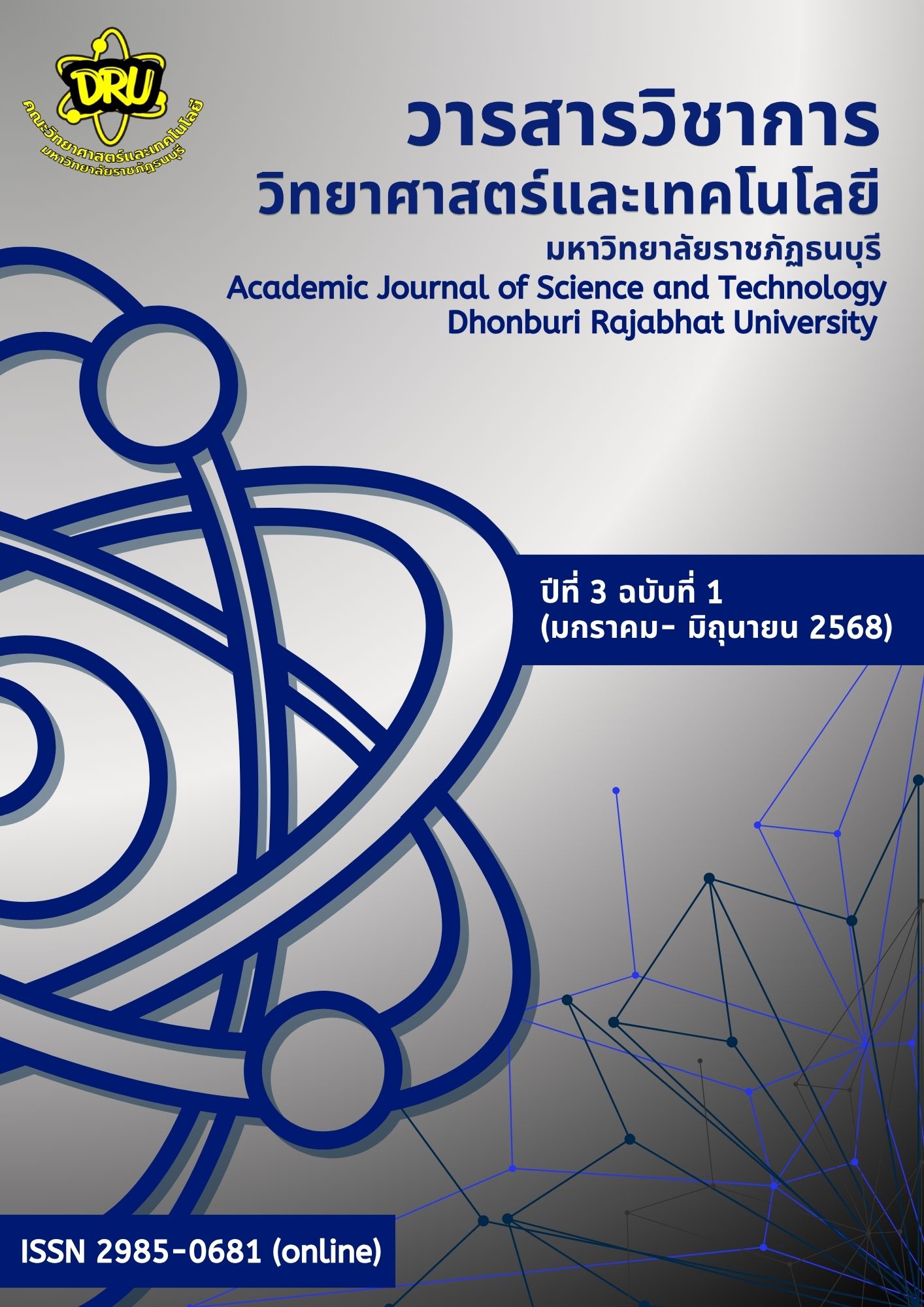The Spatial Relationship between Land Surface Temperature and Land Use in Bangkok
Keywords:
surface temperature, land use types, landsat-8 satellite, urban heat islandAbstract
This study aimed to analyze the relationship between land use types and land surface temperature (LST) derived from the analysis of Landsat-8 OLI/TIRS satellite data from February 14, 2024 (Path 129 Row 50 and Path 129 Row 51). The bands used for the analysis included Band 4 (Red) Band 5 (Near Infrared, NIR) Band 6 (Short-Wave Infrared, SWIR) and Band 10 (Thermal Infrared, TIRS). The analysis results revealed that community and built-up areas had the highest average temperature at 31.35∘C, followed by miscellaneous areas at 30.41∘C, vegetated areas at 29.71∘C, agricultural areas at 28.84∘C, and water bodies at 27.75∘C, respectively. These findings reflect that urban areas characterized by impermeable surface structures, such as concrete and asphalt, tend to retain more heat than natural areas that facilitate evapotranspiration and reduce surface temperature. Furthermore,
a statistically significant negative correlation was found between land surface temperature and the Normalized Difference Vegetation Index (NDVI), with an average correlation coefficient of -0.86, indicating that areas with dense vegetation cover tend to have lower surface temperatures. Conversely, the Normalized Difference Built-up Index (NDBI) showed a significant positive correlation with land surface temperature, with an average correlation coefficient of 0.89. This clearly suggests that areas with a higher proportion of built-up structures tend to have higher surface temperatures. The results of this study can be utilized as baseline information for land use planning and environmental management at the local level to effectively mitigate the urban heat island effect.
References
กลุ่มวิเคราะห์สภาพการใช้ที่ดิน กรมพัฒนาที่ดิน. (2565). คำนิยามข้อมูลแผนที่การใช้ที่ดิน. ค้นเมื่อ 10 มีนาคม 2568, จาก https://webapp.ldd.go.th/lpd/LandUseconditions.php
ปุณยนุช รุธิรโก. (2559). การประยุกต์เทคโนโลยีภูมิสารสนเทศในการศึกษาปรากฏการณ์เกาะความร้อน. วารสารวิจัย มสด สาขาวิทยาศาสตร์และเทคโนโลยี, 9(3), 145–162.
รติมา จันทะโก, อลงกรณ์ อินทรักษา และสุธี จรรยาสุทธิวงศ์. (2565). รูปแบบการขยายตัวของเมืองและการเปลี่ยนแปลงการใช้ประโยชน์ที่ดิน กรณีศึกษา ตำบลหนองลู อำเภอสังขละบุรี จังหวัดกาญจนบุรี. วารสารสังคมศาสตร์ มหาวิทยาลัยศรีนครินทรวิโรฒ, 25(1), 50–63.
สาวิตรี รตโนภาส สุวรรณลี, จตุรงค์ สมอาจ, กันตพิชญ์ เชียรประโคน, นิลรัตน์ นวลหงส์ และสนธยา รัตนทิพย์. (2564). ความสัมพันธ์ระหว่างอุณหภูมิพื้นผิวกับการใช้ที่ดินด้วยภาพถ่ายจากดาวเทียมหลายช่วงเวลา อำเภอเมืองอุดรธานี. วารสารวิทยาศาสตร์บูรพา, 26(1), 180–199.
สำนักการวางผังและพัฒนาเมือง. (2561). แนวโน้มการขยายตัวของที่อยู่อาศัยในเขตกรุงเทพมหานครและปริมณฑล พ.ศ. 2556–2560. ค้นเมื่อ 19 มีนาคม 2568, จาก https://webportal.bangkok.go.th
Jones, N. K. W., Acero, J. A., & Moeller, P. (2025). Shaping a Cooler Bangkok: Tackling Urban Heat for a More Livable City (English). Washington, DC: The World Bank. Retrieved March 13, 2025, from https://documents1.worldbank.org/curated/en/099032525024532810/pdf/P181082-9cc5dd2a-bc60-49ed-a145-c3a8621dc1f4.pdf
Khamwachirapitak, P., & Weerarak, A. (2019). Factors Affecting the Land Use Changes along Charansanitwong Road in Bangkok Noi District, Bangkok. Asian Creative Architecture, Art and Design, 29(2), 1–18. Retrieved March 14, 2025, from https://so04.tci-thaijo.org/index.php/archkmitl/article/view/199197
Pan, L., Lu, L., Fu, P., Nitivattananon, V., Guo, H., & Li, Q. (2023). Understanding spatiotemporal evolution of the surface urban heat island in the Bangkok metropolitan region from 2000 to 2020 using enhanced land surface temperature. Geomatics, Natural Hazards and Risk, 14(1). Retrieved March 14, 2025, from https://doi.org/10.1080/19475705.2023.2174904
The Standard. (2023). เปิดสถิติประชากรไทยปี 2565 คนไทยในวัยทำงานกำลังหดตัว ประชากรสูงวัยเพิ่มขึ้นอย่างรวดเร็ว. ค้นเมื่อ 19 มีนาคม 2568, จาก https://thestandard.co/thailand-demographics-2565/
U.S. Geological Survey. (2024). Landsat 8-9 Collection 2 Level 2 Science Product Guide. Retrieved March 14, 2025, from https://d9-wret.s3.us-west-2.amazonaws.com/assets/palladium/production/s3fs-public/media/files/LSDS-1619_Landsat8-9-Collection2-Level2-Science-Product-Guide-v6.pdf
Downloads
Published
How to Cite
Issue
Section
License
Copyright (c) 2025 Academic Journal of Science and Technology, Dhonburi Rajabhat University

This work is licensed under a Creative Commons Attribution-NonCommercial-NoDerivatives 4.0 International License.


